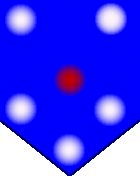Specifications:
Dimensions- Length: 22.5 ft.
- Width: 11.2 ft.
- Height: 9.8 ft.
- Weight: 49.4 tons
- Number Built: around 6,000
Armor & Armament
- Primary Gun: Rheinmetall-Borsig 1 x 7.5 cm KwK 42 L/70
- Secondary Armament: 2 x 7.92 mm Maschinengewehr 34 machine guns
- Armor: .60 in. to 4.72 in.
Engine
- Engine: V-12 petrol Maybach HL230 P30 690 hp
- Speed: 34 mph
- Range: 155 miles
- Suspension: Double torsion bar with interleaved road wheels
- Crew: 5 (Driver, radio-operator, commander, gunner, loader)
Design & Development:
Development of the Panther began in 1941, following encounters with Soviet T-34 tanks in the opening days of Operation Barbarossa. Proving superior to their current tanks, the Panzer IV and Panzer III, the T-34 inflicted heavy casualties on German armored formations. That fall, following the capture of a T-34, a team was sent east to study the Soviet tank as a precursor to designing one superior to it. Returning with the results, Daimler-Benz (DB) and Maschinenfabrik Augsburg-Nürnberg AG (MAN) were ordered to design new tanks based on the study.*******************************
In assessing the T-34, the German team found that the keys to its effectiveness were its 76.2 mm gun, wide road wheels, and sloping armor. Utilizing this data, DB and MAN delivered proposals to the Wehrmacht in April 1942. While the DB design was largely an improved copy of the T-34, MAN's incorporated the T-34's strengths into a more traditional German design. Using a three-man turret (the T-34's fit two), the MAN design was higher and wider than the T-34, and was powered by a 690 hp gasoline engine. Though Hitler initially preferred the DB design, MAN's was chosen as it used an existing turret design.
*******************************
Following prototype trials at Kummersdorf in the fall of 1942, the new tank, dubbed Panzerkampfwagen V Panther was moved into production. Due to the need for the new tank on the Eastern Front, production was rushed with the first units being completed that December. As a result of this haste, early Panthers were plagued by mechanical and reliability issues. At the Battle of Kursk in July 1943, more Panthers were lost to engine issues than to enemy action. During the war, Panthers were built by MAN, DB, Maschinenfabrik Niedersachsen-Hannover, and Henschel & Sohn.
Operational History:
The Panther was sent to frontline units in the spring of 1943, and first saw major combat at Kursk. With the correction of the production-related mechanical difficulties, the Panther became highly popular with German tankers and a fearsome weapon on the battlefield. While the Panther was initially intended to only equip one tank battalion per panzer division, by June 1944, it accounted for nearly half of German tank strength on both the eastern and western fronts. The Panther was first used against US and British forces at Anzio in early 1944.*******************************
As it only appeared in small numbers, US and British commanders believed it to be a heavy tank that would not be built in large numbers. When Allied troops landed in Normandy that June, they were shocked to find that half the German tanks in the area were Panthers. Greatly outclassing the M4
Sherman, the Panther with its high-velocity 75mm gun inflicted heavy casualties on Allied armored units. Allied tankers soon found that their 75mm guns were incapable of penetrating the Panther's frontal armor and that flanking tactics were required.
*******************************
To combat the Panther, US forces began deploying Shermans with 76mm guns, as well as the M26 Pershing heavy tank and tank destroyers carrying 90mm guns. British units frequently fitted Shermans with 17-pdr guns (Sherman Fireflys) and deployed increasing numbers of towed anti-tank guns. Another solution was found with the introduction of the Comet cruiser tank, featuring a 77mm high-velocity gun, in December 1944. The Soviet response to the Panther was faster and more uniform, with introduction of the T-34-85. Featuring an 85mm gun, the improved T-34 was nearly the equal of the Panther.
*******************************
Though the Panther remained slightly superior, high Soviet production levels quickly allowed large numbers of T-34-85s to dominate the battlefield. In addition, the Soviets developed the heavy IS-2 tank (122mm gun) and the SU-85 and SU-100 anti-tank vehicles to deal with the newer German tanks. Despite the Allies' efforts, the Panther remained arguably the best medium tank in use by either side. This was largely due to its thick armor and ability to pierce the armor of enemy tanks at ranges up to 2,200 yards.
*******************************
The Panther remained in German service until the end of the war. In 1943, efforts were made to develop the Panther II. While similar to the original, the Panther II was intended to utilize the same parts as the Tiger II heavy tank to ease maintenance for both vehicles. Following the war, captured Panthers were briefly used by the French 503e Régiment de Chars de Combat. One of the iconic tanks of World War II, the Panther influenced a number of postwar tank designs, such as the French AMX 50.




























































No comments:
Post a Comment